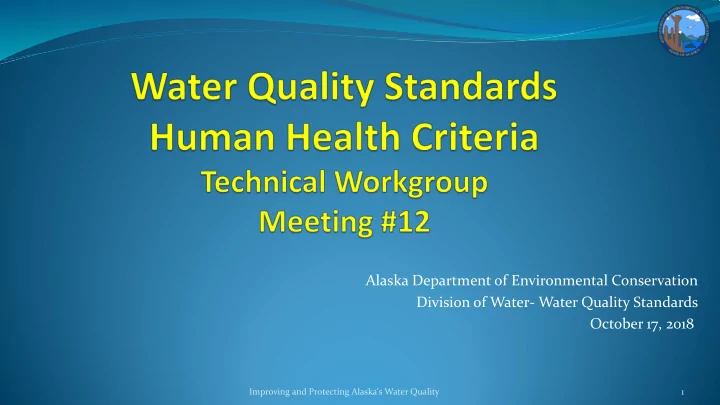

Alaska Department of Environmental Conservation Division of Water- Water Quality Standards October 17, 2018 Improving and Protecting Alaska's Water Quality 1
Webinar instructions: For audio please dial: 1-800-315-6338 Access code: 51851 Note that all lines will be muted during the presentations Public testimony will be taken at the end of the webinar. PLEASE BE RESPECTFUL OF ALL PARTICIPANTS Improving and Protecting Alaska's Water Quality 2
• Provide technical feedback on issues associated with development of human health criteria (HHC) in state water quality standards • Develop a Summary Report • Identify key sources of information that may be applicable to the process • Ensure a variety of stakeholder voices are heard Improving and Protecting Alaska's Water Quality 3
Meeting Outline • Discuss ADF&G updated FCR • Discuss draft HHC Technical Workgroup Report • Next steps Improving and Protecting Alaska's Water Quality 4
ADF&G Report Provides regional and statewide FCR percentiles Identifies and quantifies consumption by species on a regional basis Considered 110 communities Improving and Protecting Alaska's Water Quality 5
EPA-Mountain Whisper Light Provided an “expert” opinion of methodology and results Significant interaction between MWL and ADF&G staff Worked out some data issues to develop a better baseline Reviewed ADF&G Methodology and re-analyzed the data using weighting Different number of communities sampled in each region (high in SC/low in SE) Different number of sampled households in each community that participated Different number of sampled respondents in each household that participated Improving and Protecting Alaska's Water Quality 6
MWL Results Sampled and non-sampled communities were generally similar except when it comes to the number of communities ADF&G sampled in each region Pretty large regional differences between percentiles MWL-derived FCR percentiles were lower than ADF&G when weighting factors were included MWL stated that their approach may underestimate consumption due to assumption that each member of a household consumes fish equally. Improving and Protecting Alaska's Water Quality 7
ADF&G Updated FCR Percentiles Target Population-Statewide Summary FCR values Species Included. Rural- Consumer Only - Mean 165.7 g/day (Table 4) Salmon, non-marine fish, halibut, herring, marine inverts 232.8 (Seldovia Study) Rural – Consumer Only -90 th 336.1 g/day (Table 4) Salmon, non-marine fish, halibut, herring, marine inverts 528.3 (Seldovia Study) Rural- Consumer Only - Mean Salmon, non-marine fish, halibut, herring, marine inverts, seal, sea 181.2 (Table 5) lion Rural – Consumer Only -90 th Salmon, non-marine fish, halibut, 364.8 (Table 5) herring, marine invertebrates, seal, sea lion Rural – Consumer Only – Non-marine fish and marine 66.0/160.6 g/day Mean/90 th invertebrates Improving and Protecting Alaska's Water Quality 8
Draft HHC TWG Report Report- General Spent some time trying to make sure there’s consistency in terms and concepts Tried to incorporate all suggestions made by participants Did our best to make sure the tone was neutral- no DEC biases or policy preferences Improving and Protecting Alaska's Water Quality 9
Draft HHC TWG Report The report includes updated language pertaining to cancer risk levels; salmon and marine mammals; relative source contribution. New Appendix (G) with Alternate Viewpoints. Incorporated “alternate viewpoints” in the findings and appendix so people have a way of cross referencing specific concerns. Updated Appendix E: ADF&G Preliminary FCR Percentiles Improving and Protecting Alaska's Water Quality 10
Discussion Improving and Protecting Alaska's Water Quality 11
Next steps DEC will post the three reports on our webpage and accept informal public comments DEC will not issue a formal response to comments Will use this information as we conduct outreach prior to draft rulemaking DEC will conduct outreach to key stakeholders/interested parties in Fall 2018-Spring 2019 Draft rulemaking in Fall 2019 Improving and Protecting Alaska's Water Quality 12
Next steps At this time DEC does not anticipate holding another HHC TWG meeting Fulfilled its purpose of vetting the different issues and providing DEC you your unique technical perspectives 13 is bad luck Feedback for us is welcome How did the process work for you? Pros/Cons Improving and Protecting Alaska's Water Quality 13
Thank you!! Improving and Protecting Alaska's Water Quality 14
Public Comment Improving and Protecting Alaska's Water Quality 15
Recommend
More recommend